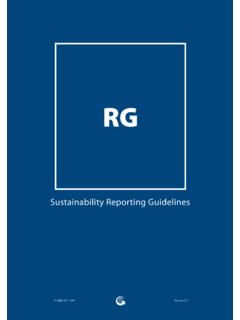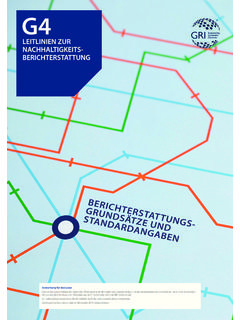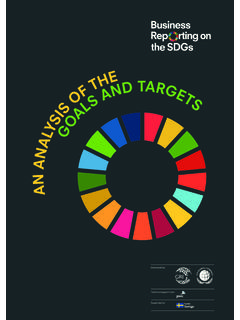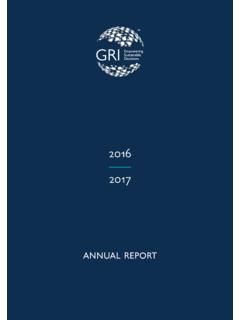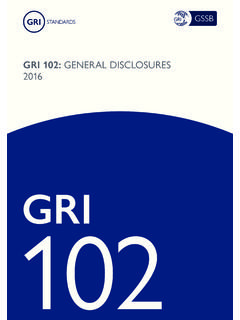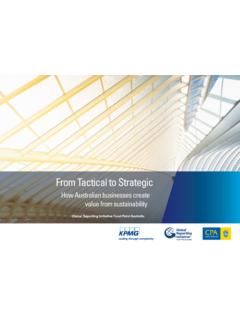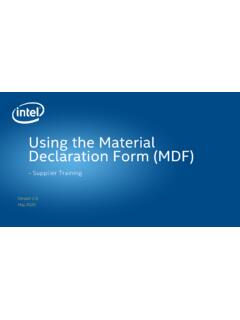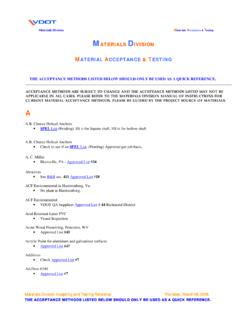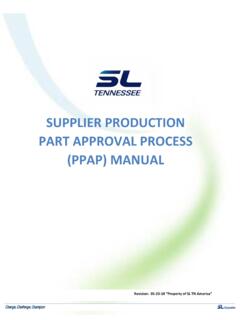Transcription of GRI 204: PROCUREMENT PRACTICES 2016 - GRI - Home
1 GRI 204: PROCUREMENT PRACTICES 2016 GRI 2042 GRI 204: PROCUREMENT PRACTICES 2016 ContentsIntroduction 3 GRI 204: PROCUREMENT PRACTICES 51. Management approach disclosures 52. Topic-specific disclosures 7 Disclosure 204-1 Proportion of spending on local suppliers 7 Glossary 8 ResponsibilityThis Standard is issued by the Global Sustainability Standards Board (GSSB). Any feedback on the GRI Standards can be submitted to for the consideration of the GSSB. ScopeGRI 204: PROCUREMENT PRACTICES sets out reporting requirements on the topic of PROCUREMENT PRACTICES . This Standard can be used by an organization of any size, type, sector or geographic location that wants to report on its impacts related to this referencesThis Standard is to be used together with the most recent versions of the following 101: FoundationGRI 103: Management Approach GRI Standards GlossaryIn the text of this Standard, terms defined in the Glossary are dateThis Standard is effective for reports or other materials published on or after 1 July 2018.
2 Earlier adoption is this Standard Note: This document includes hyperlinks to other Standards. In most browsers, using ctrl + click will open external links in a new browser window. After clicking on a link, use alt + left arrow to return to the previous 204: PROCUREMENT PRACTICES 2016A. Overview This Standard is part of the set of GRI Sustainability Reporting Standards (GRI Standards). These Standards are designed to be used by organizations to report about their impacts on the economy, the environment, and GRI Standards are structured as a set of interrelated, modular standards. The full set can be downloaded at There are three universal Standards that apply to every organization preparing a sustainability report:GRI 101: FoundationGRI 102: General DisclosuresGRI 103: Management Approach An organization then selects from the set of topic-specific GRI Standards for reporting on its material topics.
3 These Standards are organized into three series: 200 (Economic topics), 300 (Environmental topics) and 400 (Social topics). Each topic Standard includes disclosures specific to that topic, and is designed to be used together with GRI 103: Management Approach, which is used to report the management approach for the Using the GRI Standards and making claims There are two basic approaches for using the GRI Standards. For each way of using the Standards there is a corresponding claim, or statement of use, which an organization is required to include in any published materials. 1. The GRI Standards can be used as a set to prepare a sustainability report that is in accordance with the Standards. There are two options for preparing a report in accordance (Core or Comprehensive), depending on the extent of disclosures included in the report. An organization preparing a report in accordance with the GRI Standards uses this Standard, GRI 204: PROCUREMENT PRACTICES , if this is one of its material Selected GRI Standards, or parts of their content, can also be used to report specific information, without preparing a report in accordance with the Standards.
4 Any published materials that use the GRI Standards in this way are to include a GRI-referenced 204: PROCUREMENT PRACTICES is a topic-specific GRI Standard in the 200 series (Economic topics).GRI 101: Foundation is the starting point for using the GRI Standards. It has essential information on how to use and reference the Section 3 of GRI 101: Foundation for more information on how to use the GRI Standards, and the specific claims that organizations are required to include in any published materials. GRI 103 GRI 102 Topic-specificStandardsUniversal StandardsStarting point for using the GRI StandardsGRI 101 FoundationGeneral DisclosuresManagement ApproachTo report contextual information about an organizationTo report the management approach for each material topicSelect from these to report specific disclosures for each material topicGRI 300 EnvironmentalGRI 400 SocialGRI 200 EconomicFigure 1 Overview of the set of GRI Standards4 GRI 204: PROCUREMENT PRACTICES 2016C.
5 Requirements, recommendations and guidance The GRI Standards include: Requirements. These are mandatory instructions. In the text, requirements are presented in bold font and indicated with the word shall . Requirements are to be read in the context of recommendations and guidance; however, an organization is not required to comply with recommendations or guidance in order to claim that a report has been prepared in accordance with the These are cases where a particular course of action is encouraged, but not required. In the text, the word should indicates a recommendation. Guidance. These sections include background information, explanations and examples to help organizations better understand the organization is required to comply with all applicable requirements in order to claim that its report has been prepared in accordance with the GRI Standards. See GRI 101: Foundation for more Background context In the context of the GRI Standards, the economic dimension of sustainability concerns an organization s impacts on the economic conditions of its stakeholders, and on economic systems at local, national, and globallevels.
6 It does not focus on the financial condition of an Standards in the Economic series (200) address the flow of capital among different stakeholders, and the main economic impacts of an organization throughout 204 addresses the topic of PROCUREMENT PRACTICES . This covers an organization s support for local suppliers, or those owned by women or members of vulnerable groups. It also covers how the organization sprocurement PRACTICES (such as the lead times it gives to suppliers, or the purchasing prices it negotiates) cause or contribute to negative impacts in the supply disclosures in this Standard can provide information about an organization s impacts related to PROCUREMENT PRACTICES , and how it manages these impacts. 5 GRI 204: PROCUREMENT PRACTICES 2016 This Standard includes disclosures on the management approach and topic-specific disclosures. These are set out in the Standard as follows: Management approach disclosures (this section references GRI 103) Disclosure 204-1 Proportion of spending on local suppliersReporting The reporting organization shall report its management approach for PROCUREMENT PRACTICES using GRI 103: Management 204: PROCUREMENT Practices1.
7 Management approach disclosuresManagement approach disclosures are a narrative explanation of how an organization manages a material topic, the associated impacts, and stakeholders reasonable expectations and interests. Any organization that claims its report has been prepared in accordance with the GRI Standards is required to report on its management approach for every material topic, as well as reporting topic-specific disclosures for those , this topic-specific Standard is designed to be used together with GRI 103: Management Approach in order to provide full disclosure of the organization s impacts. GRI 103 specifies how to report on the management approach and what information to 204: PROCUREMENT PRACTICES 2016 Management approach disclosures ContinuedGuidanceWhen reporting its management approach for PROCUREMENT PRACTICES , the reporting organization can also: describe actions taken to identify and adjust the organization s PROCUREMENT PRACTICES that cause or contribute to negative impacts in the supply chain, including: how dialogue with suppliers is used to identify PROCUREMENT PRACTICES that cause or contribute to negative impacts in the supply chain; actions taken to adjust payment policies and procedures; describe policies and PRACTICES used to select locally-based suppliers, either organization-wide or for specific locations.
8 Explain the rationale and methodology for tracing the source, origin, or production conditions of raw materials and production inputs purchased, if applicable; describe policies and PRACTICES used to promote economic inclusion when selecting PRACTICES that cause or contribute to negative impacts in the supply chain can include: stability or length of relationships with suppliers; lead times; ordering and payment routines; purchasing prices; changing or cancelling of economic inclusion can include: small and medium-sized suppliers; suppliers owned by women; suppliers which are owned by or recruit workers from members of vulnerable, marginalized, or under-represented social 204: PROCUREMENT PRACTICES 2016 Disclosure 204-1 Proportion of spending on local suppliers Reporting requirements204 -1 DisclosureReporting When compiling the information specified in Disclosure 204-1, the reporting organization should calculate the percentages based on invoices or commitments made during the reporting period, , using accruals for Disclosure 204-1 Local purchases can be made either from a budget managed at the location of operation or at anorganization s headquarters.
9 BackgroundBy supporting local suppliers, an organization can indirectly attract additional investment to the localeconomy. Local sourcing can be a strategy to help ensure supply, support a stable local economy, andmaintain community reporting organization shall report the following information:a. Percentage of the PROCUREMENT budget used for significant locations of operation that is spent on suppliers local to that operation (such as percentage of products and services purchased locally).b. The organization s geographical definition of local .c. The definition used for significant locations of operation .2. Topic-specific disclosuresAn organization is expected to compile information for economic disclosures using figures from its audited financial statements or from its internally-audited management accounts, whenever possible. Data can be compiled using, for example: the relevant International Financial Reporting Standards (IFRS), published by the International Accounting Standards Board (IASB), and the Interpretations developed by the IFRS Interpretations Committee (specific IFRS are referenced for some of the disclosures); the International Public Sector Accounting Standards (IPSAS) issued by the International Federation of Accountants (IFAC).
10 National or regional standards recognized internationally for the purpose of financial 204: PROCUREMENT PRACTICES 2016 GlossaryimpactIn the GRI Standards, unless otherwise stated, impact refers to the effect an organization has on the economy, the environment, and/or society, which in turn can indicate its contribution (positive or negative) to sustainable 1: In the GRI Standards, the term impact can refer to positive, negative, actual, potential, direct, indirect, short-term, long-term, intended, or unintended 2: Impacts on the economy, environment, and/or society can also be related to consequences for the organization itself. For example, an impact on the economy, environment, and/or society can lead to consequences for the organization s business model, reputation, or ability to achieve its supplierorganization or person that provides a product or service to the reporting organization, and that is based in the same geographic market as the reporting organization (that is, no transnational payments are made to a local supplier )Note: The geographic definition of local can include the community surrounding operations, a region within a country or a topictopic that reflects a reporting organization s significant economic, environmental and social impacts.
